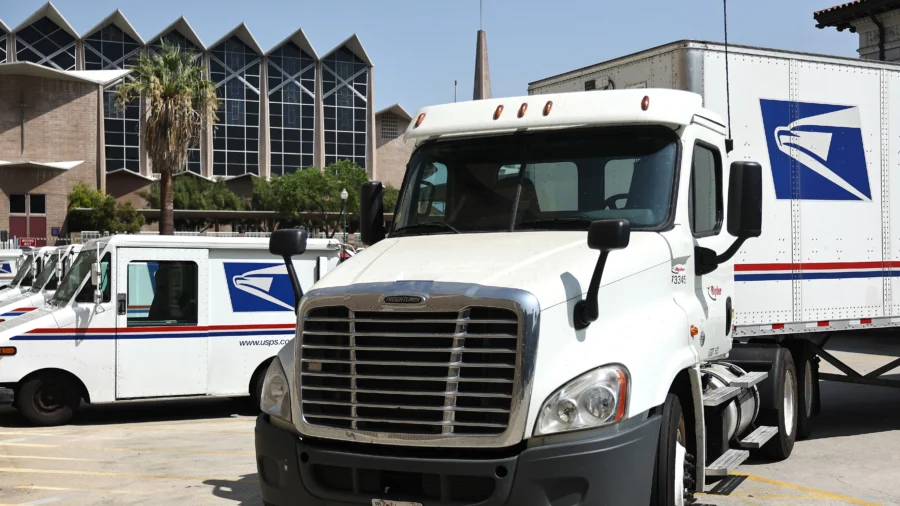The United States Postal Service (USPS) proposed a host of measures aimed at saving the agency billions of dollars annually, but which could increase delivery times in some regions of the country.
One of the proposals made by USPS is adjusting the pick-up and drop-off times of mail between post offices and processing plants when the offices are located far from regional hubs, according to an Aug. 22 press release. Another proposal could lead to faster delivery, with certain mail that used to take four days to deliver arriving in three days. However, certain regions could see slower deliveries, the USPS stated.
“Depending on location, time, and distance, expected time to deliver will increase for some ZIP code pairs,” it said. The proposed update would maintain the current 1–5 day service standards for First-Class Mail, the agency noted.
Under the proposal, people who live closer to the agency’s processing facilities could end up receiving their mail faster.
In contrast, those who live further away, including in rural areas, could experience delayed mail delivery. Lawmakers had earlier raised concerns that slower mail in rural regions could negatively affect key services such as drug deliveries.
USPS says the changes will allow the agency to “operate more reliably.” The new policies will yield “significant cost reductions,” with the agency saving an estimated $3 billion annually.
“Since 1997, we’ve seen an 80-percent decline in Single-Piece First Class Mail volume,” said Postmaster General Louis DeJoy.
The 10-year “Delivering for America” plan, implemented in 2021, is “transforming our network to better reflect today’s market demands,” he said. The plan seeks to improve the financial and operational efficiency of the agency. USPS incurred more than $87 billion in losses between 2007 and 2020.
The American Postal Workers Union (APWU) criticized the proposal, stating it is “deeply concerned” about these measures and accusing USPS of “once again planning to slow down much of the country’s mail.”
While the organization is open to implementing changes to ensure long-term viability of the postal service, it stands against any strategy that includes slowing down and providing “overall worse service” to the people, APWU said.
“Management is already failing to meet the current first-class mail service standards even after lowering delivery targets in 2021. Rather than fix the service delays and problems, these new management proposals are to simply ‘move the goalposts,’” it said.
USPS plans to hold a virtual conference in September to discuss its latest plans. It will file a formal request with the Postal Regulatory Commission (PRC) seeking an advisory opinion.
The agency said it will finalize a decision on the matter after receiving the PRC opinion. Any changes will only come into effect after the November election and peak season, which runs from Thanksgiving through New Year’s Eve, it stated.
Service Quality
In April, a Senate committee hearing examined the operations of the USPS, during which time Sen. Gary Peters (D-Mich.) criticized the agency for declining customer service.
He said in some communities, the changes to USPS’s processing and delivery network, “have already disrupted or caused declines in service.”
“I remain concerned about these changes. There is no clear evidence that shows the changes will improve service in the long run,” the senator said. “The Postal Service has even said it must execute more changes before studying their impacts—essentially plowing ahead without knowing whether service could be harmed.”
DeJoy defended the agency’s actions during the hearing. He dismissed concerns about local communities being poorly serviced due to mail processing being conducted at faraway facilities, calling such notions a “misunderstanding.”
Around 80 to 90 percent of the mail that originates in a specific city or county is usually sent to other parts of the state, country, or world, he noted.
“So, making its first processing stop further away serves to hasten its travel, not slow it. For the small percentage of mail that is local-to-local, it will continue to meet the 2-day service standard.”
In May, a group of 26 bipartisan senators asked the USPS to halt the operational changes the agency has been implementing until the modifications are reviewed by the Postal Regulatory Commission.
The agency was moving too swiftly forward and making “irrevocable changes” that have resulted in negative user experiences for communities relying on the postal network, they said in a letter.
An issue it criticized is USPS’s plan to reduce the number of truck trips and mail collection at the postal agency’s facilities. This would result in mail sitting at local offices overnight.
“USPS has begun to implement this change without notifying the public, causing critical delays for mail that requires overnight delivery,” the senators wrote. “In some rural communities, it has eliminated the possibility of overnight delivery for critical mail like medications and laboratory tests.”
Reuters contributed to this article.
From The Epoch Times

